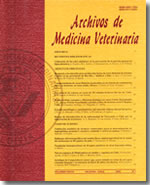Effects of long distance transport by road and sea crossing on ferry on live weight losses and carcass characteristics in lambs
Main Article Content
Abstract
The effect of local terrestrial transport for 12 h and prolonged terrestrial plus sea crossing on ferry transport for 46 h on weight loss and carcass quality characteristics was studied in Corriedale lambs from the same origin, destined to a regional or extraregional slaughterhouse, respectively. Four commercial journeys (2 local and 2 prolonged) transporting a total of 2,106 lambs were used. In each load, 25 randomly chosen lambs were individualized; live weight before and after transport, hot carcass weight and carcass bruising were registered, and samples of liver and muscle tissue were collected immediately after slaughter in order to determine the concentration of glycogen. In the cold carcasses, after 24 h refrigeration at 4 °C, pH was measured in the loin and the leg. Data obtained were submitted to statistical tests in order to determine significant differences between local and prolonged transport for all the variables, except bruises which were analysed only descriptively. In the lambs transported for 46 h the live weight losses were higher and the carcass weight and dressing percentage were lower than in lambs transported for 12 h (P < 0.01). No differences were found (P > 0.05) for liver and muscle glycogen concentration nor for pH, however, the high pH values observed in the carcasses and the low concentrations of glycogen found suggest that even local transport for 12 h produced high levels of stress and energy consumption.

